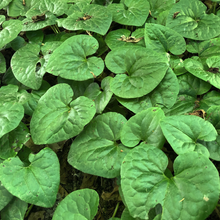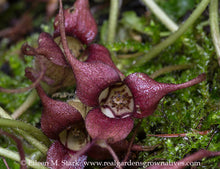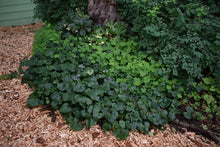Asarum caudatum
Wild Ginger is an evergreen understory plant that eventually forms a carpet of lustrous, aromatic leaves and fascinating, furtive flowers that are well-worth getting down on your hands and knees to investigate. Peek under the glossy, heart-shaped leaves in late spring and you’ll be fantastically rewarded with intricate burgundy blooms that are equal parts whimsical and wicked.
Like most evergreen groundcovers, Wild Ginger holds moisture and protects both the soil and forest floor dwellers like arthropods, which in turn support birds and amphibians. The flowers attract and are pollinated by ground beetles.
- Plant type/canopy layer: evergreen perennial herbaceous plant
- Size at maturity: 6" tall, 3' wide
- Light requirements: full shade, part-sun/part-shade
- Moisture requirements: moist soil
- Growth rate/ease: moderate to slow growth rate, moderately difficult to grow
- Bloom time: April - August
- Wildlife support: supports beneficial insects/pest eating insects, cover for amphibians, arthropods and other forest floor dwellers
- Native habitat/range: Common throughout western OR, WA and northern CA - north to British Columbia, northeast to MT; in mesic or wet places of conifer forests or rocky areas up to 1800 meters. Portland Plant List - yes.
- Special features & uses: evergreen, groundcover, edible (note: though roots are edible - it is not related to culinary ginger and consumption of large amounts could be toxic), medicinal
Gardening with Wild Ginger: Wild Ginger prefers garden areas that are shady, moist, slightly acidic, with adequate organic matter such as leaf litter. It will particularly thrive when planted with established native trees like Douglas-fir, western hemlock, grand fir, and western redcedar, as well as deciduous small trees and shrubs such as red alder, vine maple, and native hazelnut. Other associates include sword fern, deer fern, goatsbeard, fairybells, and trillium.
As with all native plants, but particularly for Wild Ginger, plant it in fall for best success and keep it hydrated with deep, infrequent waterings for the first couple of summers, especially if your site lacks many trees or is subjected to heat. When happy, it will creep by rhizome into a lush low groundcover. Since it is not fast growing, plant in multiples and space them a couple feet apart to fill an area of your woodland garden.
Photo Credit 1: Tara Lemezis, Tiny Seed Photography
Photo Credit 2: Eileen Stark
Photo Credit 3: Nikkie West, Sparrowhawk Native Plants






